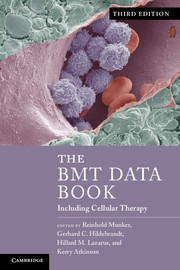Book contents
- Frontmatter
- Contents
- List of contributors
- Foreword
- Preface
- Acknowledgments
- Section 1 Basic science
- Section 2 Hematologic malignancies
- Section 3 Solid tumors
- Section 4 Nonmalignant disorders
- Section 5 Cellular therapy
- Section 6 Practical aspects and procedures
- Section 7 Complications
- Section 8 The BMT/SCT pharmacopoeia
- Section 9 HLA-testing and laboratory medicine
- Appendix Guide to the internet and literature databases relevant for BMT/SCT
- Index
Preface
Published online by Cambridge University Press: 05 August 2013
- Frontmatter
- Contents
- List of contributors
- Foreword
- Preface
- Acknowledgments
- Section 1 Basic science
- Section 2 Hematologic malignancies
- Section 3 Solid tumors
- Section 4 Nonmalignant disorders
- Section 5 Cellular therapy
- Section 6 Practical aspects and procedures
- Section 7 Complications
- Section 8 The BMT/SCT pharmacopoeia
- Section 9 HLA-testing and laboratory medicine
- Appendix Guide to the internet and literature databases relevant for BMT/SCT
- Index
Summary
The last 15 years have seen a major change, expansion, and improvement in the discipline of clinical bone marrow and blood stem cell transplantation. Unifying bone marrow and peripheral blood stem cell transplants, the term hematopoietic cell transplantation has been proposed. New data have become available to support the decision for or against transplantation. The future has started already. Basic science has made progress: new genes and microRNAs have been characterized as risk factors in the outcomes of hematologic malignancies. The involvement of natural killer cells in the graft-versus-tumor reactions has been recognized. New cell populations like dendritic cells and mesenchymal stem cells have been characterized. Clinical science has made progress. New indications for transplants have been developed and evaluated. Examples are renal cell cancer, autoimmune disorders, and amyloidosis. New stem cell sources (e.g., from cord blood) were implemented. Owing to sophisticated typing methods, unrelated transplants have become safer. Because of increased donor numbers, matched unrelated transplants can now be offered to more than 70% of patients who do not have a family match. Old indications (breast cancer) have become obsolete or are being reevaluated (chronic myelogenous leukemia) because of advances in the nontransplant arena. In the first edition of this book, transplant for multiple myeloma was put into context against “conventional” treatments. Now, autologous transplant has become the standard of care for multiple myeloma, which has to compete and will join forces with antiangiogenic agents or proteasome inhibitors. New treatment protocols for older patients or those who have significant comorbidities were introduced (reduced-intensity conditioning).
- Type
- Chapter
- Information
- The BMT Data BookIncluding Cellular Therapy, pp. xi - xiiPublisher: Cambridge University PressPrint publication year: 2013

